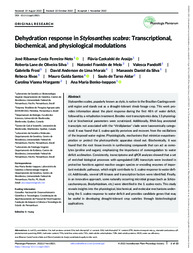Dehydration response in Stylosanthesscabra: transcriptional, biochemical, and physiological modulations.
Dehydration response in Stylosanthesscabra: transcriptional, biochemical, and physiological modulations.
Author(s): FERREIRA-NETO, R, C.; ARAÚJO, F. C. de; SILVA, R. L. de O.; MELO, N. F. de; PANDOLF, V.; FROSI, G.; MORAIS, D. A. de L.; SILVA, M. D. da; RIVAS, R.; SANTOS, M. G.; AIDAR, S. de T.; MORGANTE, C. V.; BENKO-ISEPPON, A. M.
Summary: tylosanthes scabra, popularly known as stylo, is native to the Brazilian Caatinga semi-arid region and stands out as a drought-tolerant shrub forage crop. This work pro-vides information about the plant response during the first 48 h of water deficit,followed by a rehydration treatment. Besides root transcriptomics data, 13 physiolog-ical or biochemical parameters were scrutinized. Additionally, RNA-Seq annotatedtranscripts not associated with the?Viridiplantae?clade were taxonomically catego-rized. It was found thatS. scabraquickly perceives and recovers from the oscillationsof the imposed water regime. Physiologically, mechanisms that minimize evapotrans-piration or protect the photosynthetic apparatus stood out. Biochemically, it wasfound that the root tissue invests in synthesizing compounds that can act as osmo-lytes (proline and sugars), emphasizing the importance of osmoregulation to waterdeficit acclimation. Consistently, transcriptome and qPCR analyses showed that a setof enriched biological processes with upregulated (UR) transcripts were involved inprotective functions against reactive oxygen species or encoding enzymes of impor-tant metabolic pathways, which might contribute toS. scabraresponse to water defi-cit. Additionally, several UR kinases and transcription factors were identified. Finally,in an innovative approach, some naturally occurring microbial groups (such asSchizo-saccharomyces,Bradyrhizobium, etc.) were identified in theS. scabraroots. This studyreveals insights into the physiological, biochemical, and molecular mechanisms under-lying theS. scabraresponse to water deficit and provides candidate genes that maybe useful in developing drought-tolerant crop varieties through biotechnologicalapplications
Publication year: 2022
Types of publication: Journal article
Unit: Embrapa Semi-arid Region
Observation
Some of Embrapa's publications are published as ePub files. To read them, use or download one of the following free software options to your computer or mobile device. Android: Google Play Books; IOS: iBooks; Windows and Linux: Calibre.
Access other publications
Access the Agricultural Research Database (BDPA) to consult Embrapa's full library collection and records.
Visit Embrapa Bookstore to purchase books and other publications sold by Embrapa.

